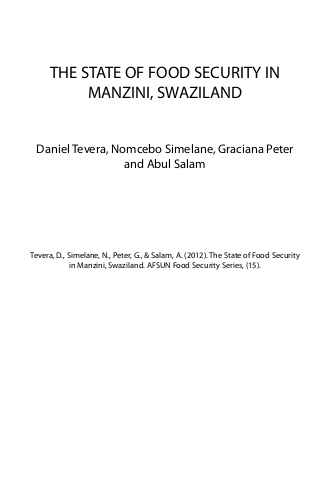Urban Food Security Series | #15

The 2006–2007 Swaziland Demographic and Health Survey researched both rural and urban households and found that the former were generally in a more precarious situation. For example, the survey found that 29% of children under the age of 5 suffered from stunted growth and that stunting was more common among rural than urban children. The survey also showed that the proportion of adults who were too thin or malnourished is relatively low especially when compared with the number who are overweight or obese. Overnutrition increases with age in both men and women in Swaziland but urban men are markedly healthier than their rural counterparts (with lower rates of under and overnutrition). However, urban and rural women have similar rates of undernutrition and overnutrition. Studies of urban food security include a 2008 survey by the Swaziland Vulnerability Assessment Committee (Swazi VAC) and WFP and a follow-up 2010 study by the Food Economy Group. The Swazi VAC study interviewed 450 households in four urban areas and concluded that only 4% of households had “poor” food consumption, 10% had “borderline” food consumption, 23% had “acceptable” consumption and 64% had “good” food consumption in terms of dietary diversity and food frequency. The study also identified five food security groups: food insecure (21% of households), food secure but poor with no stress (33%), food secure with high stress (15%), food secure (24%) and highly food secure (7%). Of the areas examined, Manzini was found to have the least overall food insecurity, “where it is assumed people have better access to a variety of foods due to higher purchasing power.” This study affords the opportunity to revisit and compare these findings about urban food insecurity in Swaziland in the light of an in-depth study of Manzini.
Links
Resource collections
- Topics
- UN Habitat - Urban Response Collection
- Urban Response - Urban Crisis Preparedness and Risk Reduction
- Urban Response Collection - Community Engagement and Social Cohesion
- Urban Response Collection - Economic Recovery
- Urban Response Collection - Environment and Climate Change
- Urban Response Collection - Housing, Land and Property
- Urban Response Collection - Urban Crisis Response, Recovery and Reconstruction
- Urban Response Collection - Urban Resilience
